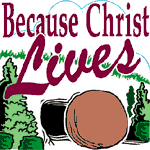|
| He was oppressed and treated harshly,
yet he never said a word. He was led as a lamb to the slaughter. And as a sheep is silent
before the shearers, he did not open his mouth. Isaiah 53:7 (NLT) |
|
Easter / Lent Fact:Golgotha
There are three references to Golgotha in the New Testament: Matthew 27;33, Mark 15:22,
and John 19:17. Each of these references are mentioned as the place where Jesus was
crucified. The Greek translation is "the place of the skull"; the last word in
of the phrase in Latin is "calva." It is from that Latin word that the term
"Calvary" in Luke 23:33 was derived.
Tradition locates Golgotha on a hill. This is either because it was on a high elevation so
it could be seen from a distance (Mark 15:40), or because the ground was shaped like a
skull or, with the church father Origen, because of the idea that Adam's skull was
supposedly found there. It is likely that Golgotha was on a hill so that the crucifixion
could be witnessed by many. A secondary purpose of a crucifixion was to humiliate and
horrify, and thus warn others of the futility of a life of crime.
The exact location of Golgotha is uncertain. There are two rival views:
1) The first proposal for the location of the Crucifixion is connected with the burial
site mentioned in John 19:41. This places Golgotha within the area now occupied by the
Church of the Holy Sepulcher. This tradition dates back to the fourth century. Constantine
had a church built at this site before 340 A. D. The fall of Jerusalem in 70 A.D. and
again in 135 A. D. means that tradition before 337 AD is unreliable.
Recent excavation of Jerusalem's walls have revealed that in Jesus' day the line of the
second city walls ran south of this proposed site of Golgotha. This would endorse the
witness of Jesus' death "outside the gait," marked by the present Russian
Alexander Hospice.
2) The second proposal for the location begins with the shape of a raised prominence. It
is a hill seen from a distance. It also is thought to be skull-shaped in appearance. This
spot is near the "Garden Tomb" (John 19:41), and close to the Damascus Gait. Two
British army officers, Condor and Gordon, proposed this site chiefly on the ground of
natural setting and reference to a "green hill" in a once popular hymn.
Sources: The Dictionary of Bible and Religion,
William Gentz | The Bible Almanac, White | Easter a Pictorial Pilgrimage -
Pierre Benoit | |


 Thoughts for
Easter
Thoughts for
Easter
